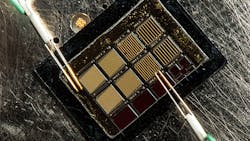Four-Junction Solar Cell Boosts Efficiency to 45.7%
This file type includes high resolution graphics and schematics when applicable.
The National Renewable Energy Laboratory (NREL) recently developed a four-junction III-V multi-junction solar cell that has a conversion efficiency of 45.7% at 234 suns concentration, one of the highest photovoltaic cell efficiencies.
The solar cell is designed to operate in concentrator photovoltaics systems in which it can be exposed to more than 1,000 suns of concentrated sunlight. (One sun concentration equals 1kW/m2.) Multi-junction cells have materials tuned to specific wavelengths that absorb different solar wavelengths, thus maximizing how much sunlight it harvests. The four material junctions are: gallium indium phosphide, a gallium arsenide, and two of gallium indium arsenide. The junctions are lattice-mismatched to the cell’s substrate. This means materials with different lattice constants are layered on top of each other. The cell’s efficiency was measured at 45.7 ± 2.3% under AM 1.5 direct spectrum at 234 suns concentration. (AM 1.5 is the air mass coefficient and describes the solar spectrum after the solar radiation has passed through our atmosphere.) However, it can use up to 700 suns concentration and still achieve an efficiency of 45.2%.
The challenges, according to the designer of the solar cell, NREL scientist Ryan France, are the dislocations between the mismatched materials. “The lattice mismatched materials require the introduction of defects,” said France. Yet NREL has found methods of isolating these dislocations in the cell’s inactive parts. This lets mismatched materials operate in multi-junction cells. The cell also includes a broadband four-layer anti-reflection coating and metamorphic tunnel junction which provides low electrical resistance and low-loss connection between sub-cells.
DoE’s Sunshot Initiative supported NREL’s work. The Sunshot Initiative’s goal is to lower the cost of solar energy and make it competitive with more traditional energy sources by the end of 2020.
This file type includes high resolution graphics and schematics when applicable.

